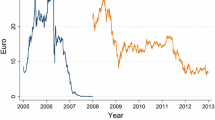Abstract
In the present paper we examine the effect of emissions permit price manipulation within an oligopolistic model. We examine the effect that positioning strategies in permits markets have on the degree of competition in the product market as well as on social welfare. The analysis is based on the concept of raising rivals' cost strategies. We find that competition in the product market can be lessened substantially. The welfare effect is ambiguous. If the leader expands its market share at the expense of a less efficient rival, or if it excludes a less efficient entrant, overall efficiency may increase despite the decrease in the industry's output. When efficiency decreases, or when consumers' protection is a policy priority, the initial distribution of permits can be used to control power in the permits market. Such interventions though, improve efficiency only when policy makers have substantial information on the technological structure of the industry, and thus, should be used with caution. Given the importance of information, sharing of information and coordination of actions between policy makers is very important.
Similar content being viewed by others
References
Borenstein, S. (1988) ‘On the Efficiency of Competitive Markets for Operating Licenses’ Quarterly Journal of Economics, 103, 357–387.
Brown-Kruse, J., S. R. Elliot, and R. Godby (1995) ‘Strategic Manipulation of Pollution Permit Markets: An Experimental Approach’ Paper presented at the Canadian Economic Association Meetings, Montreal, Québec, June 1995.
Coate, M. B., and A. N. Kleit (1994) ‘Exclusion, Collusion, or Confusion?: The Underpinnings of Raising Rivals' Costs’ Research in Law and Economics, 16, 73–93.
Dixit, A. K., and J. E. Stiglitz (1977) ‘Monopolistic Competition and Optimal Product Diversity’ American Economic Review, 67, 297–308.
Fershtman, C., and A. de Zeeuw (1996) ‘Tradeable Emission Permits in Oligopoly’ Working Paper, Department of Economics, Tilburg University.
Gaudet, G., and N. V. Long (1993) ‘Vertical Integration, Foreclosure and Profits in the Presence of Double Marginalization’ Working Paper, Université du Québec à Montreal.
Hahn, R. W. (1984) ‘Market Power and Transferable Property Rights’ Quarterly Journal of Economics, 99, 753–765.
Hahn, R.W. (1989) ‘Economic Prescriptions for Environmental Problems: How the Patient Followed the Doctor's Orders’ Journal of Economic Perspectives, 3, 95–114.
Hanley, N., and I. Moffat (1992) ‘Efficiency and Distributional Aspects of Market Mechanisms in the Control of Pollution: An Empirical Analysis’ Working Paper, Department of Economics, University of Stirling.
Hart, O., and J. Tirole (1990) ‘Vertical Integration and Market Foreclosure’ Brookings Papers on Economic Activity: Microeconomics, 4, 205–286.
Hung, M. N., and E. S. Sartzetakis (1994) ‘Is Tradeable Emission Permits Systems Superior to Command and Control?’ Working Paper, GREEN, Université Laval, Cahier 94-13.
Krattenmaker, T. G., and S. C. Salop (1985) ‘Anticompetitive Exclusion: Raising Rivals' Costs to Achieve Power over Price’ Yale Law Journal, 96, 209–295.
Krattenmaker, T. G., and S. C. Salop (1986) ‘Competition and Cooperation in the Market to Exclusionary Rights’ American Economic Review, Papers and Proceedings, 16, 109–113.
Krattenmaker, T. G., and S. C. Salop (1987) ‘Analysing Anticompetitive Exclusion’ Antitrust Law Journal, 56, 71–89.
Malueg, D. A. (1990) ‘Welfare Consequences of Emission Credit Trading Programs’ Journal of Environmental Economics and Management, 17, 66–77.
Misiolek, W. S., and W. Elder (1987) ‘Exclusionary Manipulation of Markets for Pollution Rights’ Journal of Environmental Economics and Management, 16, 156–166.
Ordover, J. A., G. Saloner, and S. C. Salop (1990) ‘Equilibrium Vertical Foreclosure’ American Economic Review, 80, 127–142.
Requate, T. (1993) ‘Pollution Control in a Cournot Duopoly Via Taxes or Permits’ Journal of Economics, 58, 255–291.
Salop, S. C., and D. T. Scheffman (1981) ‘Strategic Interaction in Multiple Markets: A Beginning to a General Theory of Dominant Firm Industries’ Mimeo. Presented at the Summer Meetings of the Econometric Society. San Diego, June 1981.
Salop, S. C., and D. T. Scheffman (1983) ‘Raising Rivals' Costs’ American Economic Review, 73, 267–271.
Salop, S. C., and D. T. Scheffman (1987) ‘Cost-Raising Strategies’ Journal of Industrial Economics, 26, 19–34.
Sartzetakis, E. S. (1993) Emission Permit Trading and Market Structure, Ph.D. Dissertation, Department of Economics, Carleton University, Ottawa, Canada.
Sartzetakis, E. S. (1996a) ‘Emissions Permits Trading as Vehicle for Raising Rivals' Costs Strategies’ Working Paper, Fondazione Eni Enrico Mattei, Milano, Italy, Nota di Lavoro 59.96.
Sartzetakis, E. S. (1996b) ‘Interaction of Competitive Markets for Tradeable Emission Permits with Oligopolistic Product Markets’ Environmental and Resource Economics, forthcoming.
Spence, A. M. (1976) ‘Product Selection, Fixed Costs and Monopolistic Competition’ Review of Economic Studies, 43, 217–236.
Tietenberg, T. H. (1985) Emissions Trading: An Exercise in Performing Pollution Policy.Washington DC: Resources for the Future, Inc.
Tietenberg, T. H. (1989) Environmental and Resource Economics, Harper Collins Publishers, Second Edition.
von de Fehr, N.-H. M. (1993) ‘Tradeable Emission Rights and Strategic Interaction’ Environmental and Resource Economics, 3, 129–151.
Ware, R. (1994) ‘Understanding Raising Rivals' Costs: A Canadian Perspective’ Canadian Competition Record, March 1994, pp. 9–17.
Author information
Authors and Affiliations
Rights and permissions
About this article
Cite this article
Sartzetakis, E.S. Raising Rivals' Costs Strategies via Emission Permits Markets. Review of Industrial Organization 12, 751–765 (1997). https://doi.org/10.1023/A:1007763019487
Issue Date:
DOI: https://doi.org/10.1023/A:1007763019487




